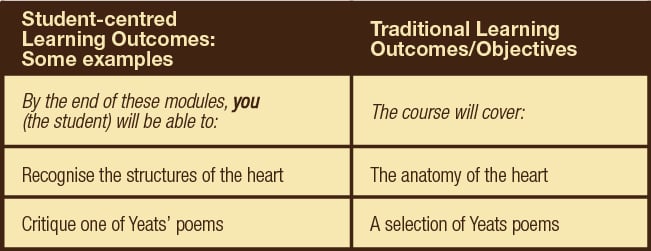Take a moment to step back from your role as an eLearning designer, instructor, or course developer and focus on yourself as a learner. Answer these questions:
- How do you learn best?
- What learning activities are the most motivational to you?
- How do you interact with other learners?
- What do you struggle with when learning new information or mastering a new skill?
Understanding your own learning preferences is an excellent place to start when considering the benefits of a learner-centered eLearning model.
Your answers to these questions are likely very different from your friends, family members, and coworkers. Yet many eLearning courses are designed so that every participant is expected to learn and perform identically.
A shift to a learner-centered design model allows you to meet the needs of all learners while maintaining rigorous expectations and quality content.
What is Learner-Centered Design?
Learner-centered design focuses on the quality of student learning (Barr & Tagg, 1995). It is based on the understanding that each learner has different characteristics and these characteristics should be employed to elevate both training and learning.
Jackson, Stratford, Krajcik, & Soloway, 2000; Quintana et al., 2000 further explained that learner-centered design "considers learning while doing; it supports learners in the ways of using the software and throughout the use of it. It also indicates how and why to do the learning tasks. Moreover, these authors have defined learner-centered design as “the new challenge for human-computer interaction, with the goal of providing support for both learning a task and doing it.”
The Four Learner-Centered Principles
According to Jonassen et al. (1995), there are four distinct attributes of learner-centered effective eLearning courses:
- Context: Learning tasks should have a real-world application that allows learners to connect personally with what they are learning.
- Construction: Learners should be able to link their own experiences and prior knowledge with new learning.
- Collaboration: A problem-solving scenario allows learners to develop, test, and analyze their ideas while being exposed to others' opinions. Each learner will arrive at an individual conclusion after the collaboration is completed.
- Conversation: Communication with and within learners is essential to effective eLearning courses. Learners should spend time in conversation while planning and making sense of new learning.
Learner-Centered Design in Practice: 4 Steps
Evolving into a learner-centered approach for your eLearning course doesn't require you to sacrifice the content or your rigorous expectations. You can make small changes over time to implement a fully learner-centered eLearning course.
These changes include:
1. Shifting your mindset:
“The design of learner-centered instruction requires a paradigm shift, challenging our beliefs about learning and the role the instructor plays in the process” (Huba & Freed, 2000).
The first step to converting your eLearning courses to learner-centered experiences is to change your mindset. Once you get into this mindset, the energy behind the content is completely different. This new way of thinking will influence all of your instructional decisions: what content to include or not include, how to organize it and teach it, and how to assess it. ALL with the learner in mind..
Also read: Would You Take Your Own eLearning Course?
2. Getting to know your learner:
It is important to remember that there isn't a "one size fits all" approach to building eLearning courses. All learners are different, and there are multitudes of ways to craft courses that work for a variety of individuals. Failing to pay attention to the diversity of your audience can make a huge difference in the success of the course and may result in the inability to facilitate student-centered content.
A quick learner analysis will provide you with the information to target students for additional support and to learn the strengths of individual students.
Learn more: A Template to Carry Out an eLearning Audience Analysis
3. Rethinking the learning objectives:
Consider shifting your perspective to create objectives aimed at describing what the student will be able to do at the end of the course. This is an essential part of the learner-centered model, according to UCD Centre for Teaching and Learning 2005.
Instead of just describing the objectives in a boring way, find other alternatives to focus on what the students will be able to do, the tasks they must undertake, and the tools they can use to deal with those tasks.
 Image Source:
Image Source:
Student-centred learning: What does it mean for students and lecturers?
4. Shifting the balance of power
Creating eLearning courses that shift the balance of power to the student is an excellent way of requiring more learner responsibility. Instead of waiting for content to be delivered students are engaged in creating their own meaning and learning. This change may seem a bit frightening at first, but it is definitely worth it!
Shifting the balance of power provides students the opportunity to manage their own knowledge, their own pace, and reflect on their individual efforts. There are a variety of technologies available, including online quizzes, blogs, and discussion boards, that support this philosophical shift to effective eLearning courses.
Also read: The Empowered Learner: 4 Things You Need to Know
Final thoughts
Changing to a learner-centered model for your eLearning course doesn't change the content or radically alter the outcomes. It simply shifts the focus, responsibility, and expectations to the individual learner's strengths and weaknesses and then shapes the course to meet these needs.


